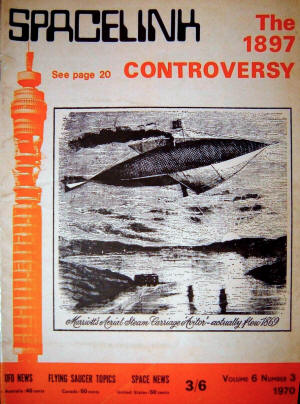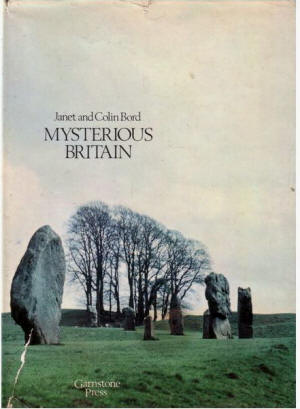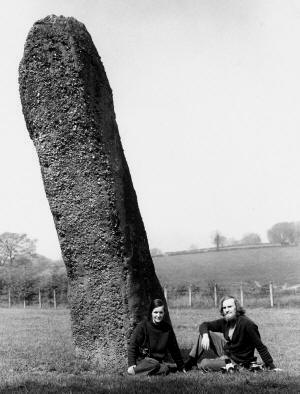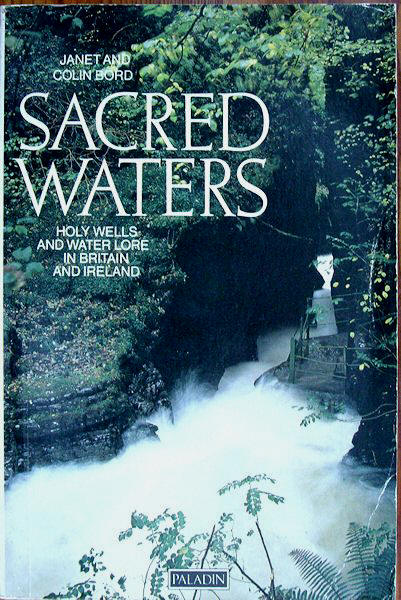|
|
| home | exhibitions | interviews | features | profiles | webprojects | archive |
|
Janet Bord on Colin Bord, UFO's and Mysterious Britain Janet Bord is a writer and landscape folklorist, and was a key member of the early British Earth Mysteries movement.
Can you explain why UFO’s were of so much interest at the time? There was a big ‘flap’ in Britain in the late sixties, triggered, I think, by sightings of bright lights over South-West England. I believe they were eventually found to have been caused by planes re-fuelling in flight. The newspapers were full of sighting reports, from all over the country, because the initial sightings had caused people everywhere to start looking skyward, and of course a lot of them saw things they could not explain, probably because normally they took little notice of what might be going on overhead, so were unfamiliar with natural events such as the moon seen through clouds, an especially bright Venus, satellites crossing the sky, shooting stars, and so on. In response to the ‘flap’ local UFO groups were set up, especially in those areas where numerous sightings were being reported, and many people who joined these groups found a new ‘hobby’, sitting on hilltops in the middle of the night, sometimes with UFO detectors, trying to spot UFOs.
I know Colin took photos and wrote articles for Gandalf’s Garden, the occult revival magazine, in the late 60’s. What was full the extent of his involvement? Colin was never a member of the core Gandalf’s Garden group; he was mainly writing articles for the magazine. This was before we met. I do remember visiting Gandalf’s Garden at some point after I moved to London, but we would not have considered ourselves as part of that community.
Were either of you publishing any other writing or photography during this period? In the late ‘60s I was editing Lionel Beer’s UFO magazine 'Spacelink', so I wrote quite a bit for that. I also wrote articles for 'Flying Saucer Review'. When living in Leicester I had worked as an assistant editor with a children’s book publisher, and after moving to London in 1970 I worked as a freelance editor for many London publishers. I also started to think about writing books, and my first effort was 'Honey – Natural Food and Healer', a small book which I wrote for Thorsons, a publisher specialising in health matters, for whom I worked part-time. I also wrote a few articles, illustrated with my own photographs and published in county magazines, etc.
Do you think the folk revival of the sixties was an influence in any way – in the sense that perhaps it made young people think differently about the landscape and its folk traditions? This may well have applied to some people, but we weren’t involved in the folk music scene in any way.
How did ‘Mysterious
Britain’ come about? I was approached by Michael Balfour, owner of Garnstone Press, who
was looking for someone to do the picture research for a book he
envisaged, but for which he only had a title – Mysterious Britain. He
asked me because he knew that one of the editorial skills I was offering
to publishers was picture research, and he also knew that I was part of
the ‘mysteries’ community. I agreed to take on the job, thinking that I
would be able to use plenty of our own pictures. Colin was a freelance
professional photographer and had already taken numerous ‘atmospheric’
photographs, and together we were already travelling around visiting and
Once we had started researching around the theme of the book, and collecting pictures, I realised that I could just as easily write it too. A format was agreed, i.e. a basic introduction to each topic, followed by a selection of photographs with captions. My suggested list of topics was also agreed, and thereafter we had a free hand. We didn’t have the luxury of spending a year or two visiting sites and collecting material. So far as I recall, we only had a few months, and so the work was very intensive. We were able to use photographs we had already taken since getting together, I also obtained photographs from other photographers and agencies, and we went out on short excursions to take some photographs especially for the book. I am sure we would have gone on longer field trips had we had the time. We certainly did so when creating later books dealing with British ancient sites and folklore. In the early days we tended to sleep in the car, or in the open air, not being able to afford to spend money on accommodation. Later we stayed in B+Bs.
You mention being part of the ‘mysteries community’. In what sense was it a community? The Ley Hunter magazine started up in 1962 and from 1969 until 1976 was edited by Paul Screeton. Various people including John Michell and Paul Devereux linked up around this time, and I remember we used to socialise with Paul Devereux as he too lived in London. Strangely, we discovered that we were close in age and were living in the same village near Leicester in our early years, though so far as I am aware we never met! In the seventies we also ended up living in cottages not many miles apart in mid-Wales. I can’t remember specifically how we communicated and/or met up, but we certainly did all interact to some degree. Since it was long before the age of the computer and email and mobile phones, we all tended to write a lot of letters.
Where were you in London? Colin and I in W9 not far from Notting Hill, so we were all reasonably accessible but I don’t remember that we were constantly meeting up. We two were certainly too busy trying to earn a living through self-employment, to be able to spend much time socializing!
Monica Sjoo, Goddess-feminist, commented that The Ley Hunter was 'male-dominated'. Would you recognise this gender imbalance? Was it a problem? I would not have said that The Ley Hunter, or the earth mysteries field in general, was male-dominated. There were plenty of women in the field. Such a statement would never have occurred to me, since I have always worked with, socialised with, been friends with, people, regardless of their sex! I have always had as many men friends and colleagues as women, and I have never differentiated between them. I don’t think I would have wanted to socialise with rampant feminists anyway...
Who do you think bought it? Is there a sense, perhaps, that you were helping people see the British landscape in a fresh, new way? My attitude towards my books has always been that once one is finished, I am keen to move on to the next project. The new project takes all my attention and I tend to have little concern as to who reads earlier books or how they are received! So I’m honestly not sure who bought the book, but I guess that as the first edition was relatively expensive, it would have been the later paperback edition that most enthusiasts bought. It probably is true that the book introduced people to new aspects of the landscape, and as a result more young people wanted to go out and explore it for themselves. I hope that is true, anyway.
I know you wrote some books independently of Colin in the 70’s (eg on mazes and astral travel) but later in the decade you brought out two more books together, namely 'The Secret Country' (1976) and 'A Guide to Ancient Sites in Britain' (1978). Can you recall how you shared the work? We travelled together on research trips, took photographs together (usually Colin took colour transparencies and I used black and white film), and back home Colin undertook all the photographic darkroom work, processing the films and making black and white prints for use in our books. I did all the research and writing. We did a lot of travelling for our books on the British landscape, so that we could experience the places for ourselves and also get up-to-date and, wherever possible, atmospheric photographs of them.
‘Alien Animals’ (1981), which was followed by ‘Bigfoot Casebook’, seems to mark a new, more ‘Fortean’ departure for you. How did these books relate to the earlier Earth Mysteries books? Are they linked because much of the content relates very much to the folklore of specific places and landscapes? As noted earlier, we had always been interested in a wide range of mysteries. I suspect I thought that, for a change, it would be interesting to move into the area of cryptozoology for our next book. So I don’t think these books related to the earth mysteries books in any way – I was simply varying our output! It is true however that for all of them the landscape and its folklore are significant, but that’s probably because landscape folklore is at the heart of my interest. I suppose, thinking about it, most of my writing has landscape folklore at its core.
Was there also a sense, by the 80’s, that some of the enthusiasm generated by John Michell’s early books had faded, and ley-theory had, for many, lost its interest? Possibly, but I’m not sure about this. I tended to follow my own particular interests without really considering how they related to other people’s interests! I never thought that I must write about X simply because that was what the readers wanted. The research was the most important aspect to me, so that I would research my chosen topic, and when the research was done, converting it into a book seemed to be the natural progression. I never thought that I had a readership to satisfy, and once the manuscript had gone off to the publisher, apart from proof-reading it later, I virtually forgot about it and moved on to the next project. I never sought personal publicity and never (well, rarely) gave interviews.
Were you involved with Fortean Times? Did you know and work with Bob Rickard (founding editor) much? We knew Bob from 1970 onwards and worked closely with him. Again I kept all our correspondence but it is now in the AFU archive so I cannot consult it for dates of letters and topics of discussion. It was Bob who first published Doc’s photograph of the Loch Ness Monster (above right), and also Bob who decided that we should look after the image and perhaps use it as the starting point of a collection of other Fortean images. In this way Fortean Picture Library was born.
Living in Wales, I have had more opportunity to visit many of the surviving Welsh wells, and I am currently researching all the saints’ wells of Wales, i.e. those named for saints, rather than any other named wells. Although many of them can no longer be located, I have recorded references to more than 800 saints’ wells in Wales, and visited many of those that have survived. I am into my ninth year on this particular project, and am still finding references to wells that have been totally forgotten other than in a field name.
http://www.bordbooks.co.uk/books/index.html 20/3/17 |
|
|





 You
moved to Wales later in the 70's. Did this change your outlook, or your
working pattern in any way? Was it this move that led to the
establishment of the Fortean Picture Library? We bought our first house in Wales in 1972 and then for six
years we travelled between Montgomery and London while we were
renovating that house. We moved permanently to Montgomery in 1978. I
don’t think the move changed our outlook or our pattern of working – we
just had a bit more space for our growing collection of books. And of
course we had inspirational landscapes on the doorstep. The Fortean
Picture Library was created just before we moved from London. The move
had nothing to do with the creation of that collection; we had already
been building up a collection of landscape images and selling them to
magazines and book publishers.
You
moved to Wales later in the 70's. Did this change your outlook, or your
working pattern in any way? Was it this move that led to the
establishment of the Fortean Picture Library? We bought our first house in Wales in 1972 and then for six
years we travelled between Montgomery and London while we were
renovating that house. We moved permanently to Montgomery in 1978. I
don’t think the move changed our outlook or our pattern of working – we
just had a bit more space for our growing collection of books. And of
course we had inspirational landscapes on the doorstep. The Fortean
Picture Library was created just before we moved from London. The move
had nothing to do with the creation of that collection; we had already
been building up a collection of landscape images and selling them to
magazines and book publishers.
 I
notice that you have taken a special interest in holy wells more
recently. Are they sites that are found all over the country? What is
their appeal and interest to you?
I wrote my first book on holy wells, Sacred Waters, in 1985, so my
interest in them goes back several decades. As my 2008 guidebook, Holy
Wells in Britain: A Guide, shows, there are holy wells in all parts of
the country. My interest in them is again related to their links with
the landscape, and also to their significance for the people who visited
them, the wide-ranging nature of this being demonstrated in my other
book on holy wells, Cures and Curses: Ritual and Cult at Holy Wells
(2006).
I
notice that you have taken a special interest in holy wells more
recently. Are they sites that are found all over the country? What is
their appeal and interest to you?
I wrote my first book on holy wells, Sacred Waters, in 1985, so my
interest in them goes back several decades. As my 2008 guidebook, Holy
Wells in Britain: A Guide, shows, there are holy wells in all parts of
the country. My interest in them is again related to their links with
the landscape, and also to their significance for the people who visited
them, the wide-ranging nature of this being demonstrated in my other
book on holy wells, Cures and Curses: Ritual and Cult at Holy Wells
(2006).